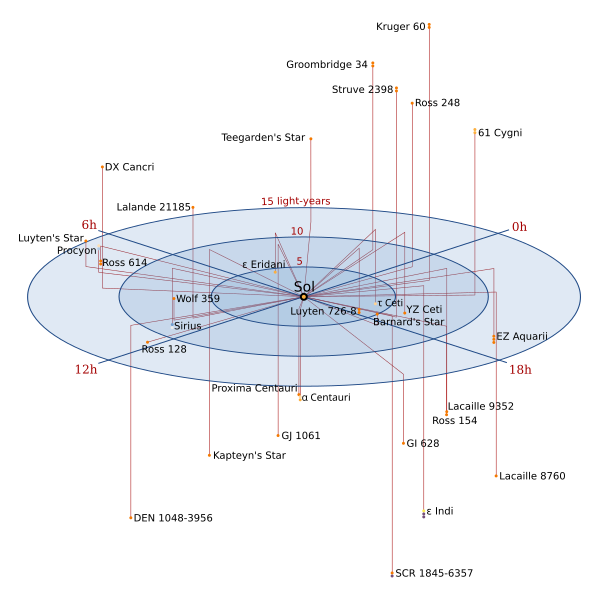
Caption: A extraterrestrial map showing the locations of the nearest stars.
Features:
- Original Caption:
"An extraterrestrial map
showing the location of every star
within 14
light-years of
the Sun.
There are 32 known
stars in this region, including
the Sun.
The stars are colored according to
their spectral type
which may NOT correspond to their
observed color, either
below or above the Earth's atmosphere.
Some of the location and other information shown
may be preliminary and NOT entirely accurate as a result.
For more and possibly more accurate information on these
nearest stars,
see
Wikipedia:
List of nearest stars and brown dwarfs.
If a "star" is actually a multiple star system (e.g., a binary or a triple star system), then the component stars are shown stacked vertically: the actual position of the multiple star system is the "star" closest to the blue plane.
The stars on this extraterrestrial map may NOT all be visible to the naked eye as many are red dwarfs (i.e., M and K dwarfs).
The equatorial coordinate system (with equatorial coordinates right ascension (RA) and declination) is used. The RA hours (15° each) are marked and distances in multiples of 5 light-years are marked for the blue plane."
(Somewhat edited.)
- The blue
plane
is the plane
of the celestial equator, and therefore
is all at zero
declination.
- Sirius (the Dog star) in
constellation
Canis Major
and Procyon
in constellation
Canis Minor
are the only really well known
northern celestial hemisphere
stars
among the
nearest stars.
Sirius is the brightest star in the sky and is to the southeast of constellation Orion---so anyone can find it.
- The
stellar parallaxes
(determined for the standard baseline
of 1
astronomical unit (AU))
and other quantities for some of the nearest stars
are shown in Table: Nearest Stars below.
Recall, we do NOT try to memorize the values in tables:
we contemplate them while we look at them.
Table: Nearest Stars
Name Parallax Distance Spectral Type Mass Luminosity (arcseconds) (parsecs) /Luminosity Class (M_☉) (L_☉)
Sun 1/206265 G2 V 1 1 Proxima Cen 0.772 1.30 M5.5 V 0.107 8.2*10**(-4) Alpha Cen A 0.747 1.34 G2 V 1.144 1.77 Alpha Cen B 0.747 1.34 K0 V 0.916 0.55 Barnard's star 0.547 1.83 M4.0 V 0.166 3.6*10**(-3) Wolf 359 0.419 2.39 M6.0 V 0.092 3.5*10**(-4) Lalande 21185 0.393 2.54 M2.0 V 0.464 0.023 * * Sirius A 0.380 2.63 A1 V 1.991 26.1 Sirius B 0.380 2.63 white dwarf 0.500 2.4*10**(-3) * * Procyon A 0.286 3.50 F5 IV-V 1.569 7.73 Procyon B 0.286 3.50 white dwarf 0.500 5.5*10**(-4) 61 Cyni A 0.286 3.50 K5.0 V 0.703 0.16 61 Cyni b 0.286 3.50 K7.0 V 0.630 0.095
-
Notes:
- References: FK-A-6 for everything, except the luminosities; CK-A-4 for the luminosities. See also Wikipedia: List of Nearest Stars.
- The asterisk indicate omissions of rather obscure little stars.
- The nearest stars are often intrinsically quite dim and the overlap between Table: Nearest Stars and the stars in Wikipedia: List of brightest stars is NOT big. See also Table: Stars of Highest Apparent Brightness.
- Distance (pc) = (1 AU)/[ parallax ('')]. 1 AU is the standard baseline for measurements of stellar parallax.
- Listed stars and some others
from the extraterrestrial map:
-
61 Cygni (binary AB)
Alpha Centauri (AKA Α Centauri, binary Alpha Centauri AB)
(Alpha Centauri A,
Alpha Centauri B),
Barnard's Star,
Epsilon Eridani,
Kaptyen's Star,
Lalande 21185,
Luyten 726-8,
Procyon (AKA Α Canis Minoris, binary)
(Procyon A,
Procyon B (a white dwarf)),
Proxima Centauri (distance 1.30197 pc
= 4.2465(3) ly, AKA Alpha Centauri C since gravitationally-bound to Alpha Centauri AB),
Sirius (AKA α Canis Majoris, binary)
(Sirius A
Sirius B (a white dwarf)),
Tau Ceti,
Wolf 359,
YZ Ceti.
Credit/Permission: User:Inductiveload,
2008 /
Public domain.
Image link: Wikipedia:
File:Nearby Stars (14ly Radius).svg.
Local file: local link: star_table_nearest.html.
File: Star file:
star_table_nearest.html.